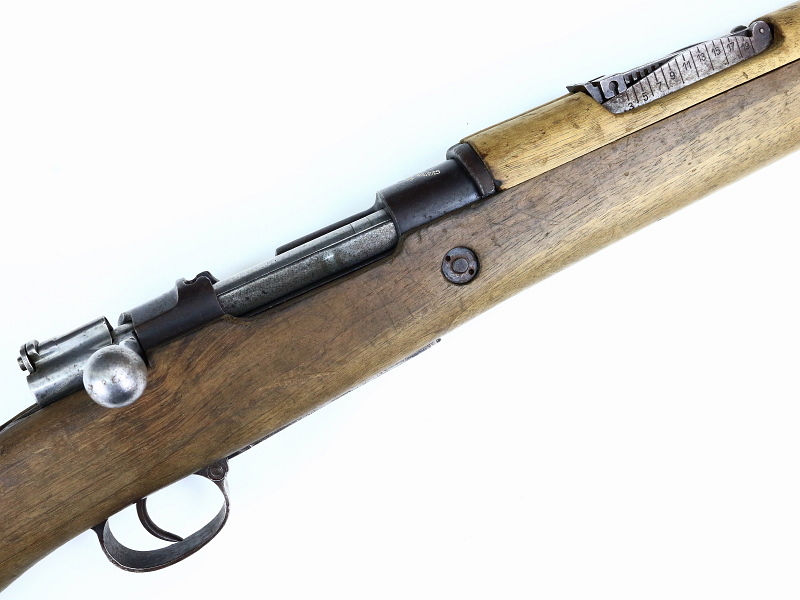

The new M1893 version incorporated a staggered 5-round magazine that did not extend below the bottom of the stock. Spain placed an order for 20,000 of the M1892 rifles on 21 July 1893, with a further 10,000 added on 27 August, but the design quickly led to an improved version, the Model 1893, which replaced the M1892s ordered. Other internal changes were made to simplify the action and increase its reliability and safety, including alterations to the sear to prevent it from releasing the firing pin if the bolt was not fully in battery. The stripper clips and the clip guides were improved to make them easier to use. The magazine box and trigger guard were machined as a single piece, preventing the box from being removed and lost, though the magazine was still a single-stack design that extended below the bottom of the stock. The M1892 rifle introduced a number of innovations to remedy the problems of the earlier rifles, including the large non-rotating claw extractor on the bolt, which prevented double-feeds. At the same time, Mauser developed the 7×57mm Mauser cartridge for the Spanish Army, which adopted the round the following year for the M1892 rifles. Between 5,000 and 8,000 of the rifles were built for Spain. Mauser's design work produced the Model 1892, a transitional design that was manufactured in limited numbers for the Spanish Army. As a result, Paul Mauser decided to design a new rifle that would correct the problems with the earlier rifles, and allow the company to secure more arms contracts. The stripper clip guide and the clips themselves were also unreliable and the bolt design allowed the rifle to double-feed rounds of ammunition. Among the issues that had been identified were an unreliable extractor, a detachable box magazine that was frequently lost and extended below the bottom of the stock, which caused problems with carrying the rifle slung.
1916 SPANISH MAUSER HISTORY SERIES
Trials with these guns provided a series of improvement suggestions for Mauser in addition to Spanish experiences, by that time, the 1889, 1890, and 1891 series of Mauser rifles had been in service with various armies long enough to highlight deficiencies in the designs. The impetus for the change was a series of defeats of Spanish forces around the enclave at Melilla in North Africa. These rifles did not satisfy the Spanish Army, and so on 2 December 1891, the Army ordered 1,200 Model 1891 Mausers that used new smokeless powder ammunition. In 1887, the Spanish Army began trials of the Turkish Model 1887 Mauser rifles, which utilized black powder cartridges. The marked superiority of the M1893 over its American opponent in the Spanish–American War, the Krag–Jørgensens, led the US Army to develop the M1903 Springfield, which itself heavily copied Mauser's designs. For his work, Mauser received the Grand Cross of the Order of Military Merit from Spain. The M1893 proved to be a major success for Mauser, as it provided the basis for later developments, including the Models 18-commonly referred to as Swedish Mausers-the Model 1895, and ultimately the Gewehr 98, one of the most successful bolt-action rifle designs ever produced. In Ottoman service, M1893 rifles saw limited action during the Greco-Turkish War of 1897, the Balkan Wars of 1912–1913, and World War I in 1914–1918. The converted rifles were used for training and for the Guardia Civil through the 1950s. The M1916 short rifles remained in production in Spain until 1951, and many of these later rifles were converted to shoot either 7.92×57mm Mauser or 7.62×51mm NATO, including some that were extensively modified as the FR7. All versions of the rifle saw extensive service in the Spanish Army, beginning in the Spanish–American War in 1898, the Rif War of 1920–1927, and the Spanish Civil War of 1936–1939. The M1893 was developed into several variants, including a shortened carbine adopted by the Spanish as the M1895, and as the M1913 and M1916 short rifles. The M1893 introduced a short staggered-column box magazine that fit flush with the bottom of the stock the magazine held five smokeless 7×57mm Mauser rounds, which could be reloaded quickly by pushing a stripper clip from the top of the open bolt. The M1893 was based on the experimental M1892 rifle, which Paul Mauser developed for the Spanish Army as part of a program to correct deficiencies in the earlier 1889, 1890, and 1891 series of Mauser rifles. The Mauser Model 1893 is a bolt-action rifle commonly referred to as the Spanish Mauser, though the model was adopted by other countries in other calibers, most notably the Ottoman Empire.

Illustration of a Mauser Model 1893 rifle


 0 kommentar(er)
0 kommentar(er)
